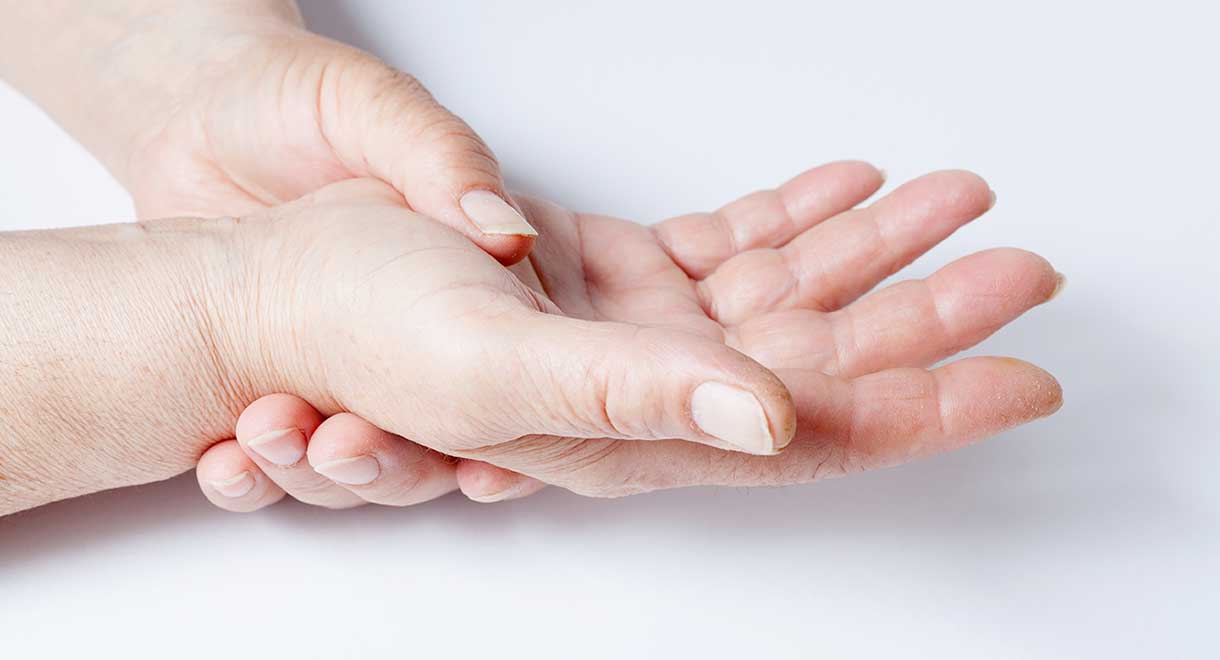Scleroderma
Scleroderma is an autoimmune disorder of connective tissue characterised by thickening and hardening of the skin, particularly of the fingers. Internal organs like the esophagus, lungs, intestine, kidneys and heart can also be involved.
What are the symptoms of scleroderma?
- Typically, the skin in scleroderma is bound down to underlying structures producing tapering in the fingers known as sclerodactyly. Fibrosis around the joints may cause flexion deformities and loss of fine movements.
- A binding down of the facial skin produces beaking of the nose, puckering around the mouth and limitation of mouth opening.
- Raynaud’s phenomenon, in which there is spasm of the arteries supplying the fingers, is characteristic of scleroderma. This is where the fingers turn from white to blue to red in response to cold, accompanied by numbness, tingling, burning and pain.
- Most patients with scleroderma have gastro-esophageal reflux causing heartburn and indigestion. Occasionally, a narrowing of the esophagus develops leading to difficulty swallowing.
- Reduced motility of the intestine may occur, resulting in constipation and bloating, or sometimes encouraging bacterial overgrowth and causing diarrhea.
- Kidney involvement in scleroderma may produce a severe rise in blood pressure or rapidly progressive kidney failure, requiring urgent treatment.
- Fibrosis (hardening and stiffening) of the lungs is the most common manifestation of lung involvement in scleroderma and may be fatal.
- Fibrosis of the heart muscle causing heart failure is a late slowly progressive complication in severe cases.
- Arthritis affecting numerous joints is frequently the first sign of scleroderma; acute inflammation of the muscles occurs occasionally.
- Impotence is common in men with severe scleroderma, and female fertility is often reduced.
The course and severity of scleroderma is quite variable. In mild cases, skin involvement is limited to thickening or swelling of the fingers with no internal organ involvement, except for perhaps the esophagus. At the other end of the spectrum there is diffuse marked skin thickening of most of the body, with severe internal organ involvement progressing to death within a few years.
What causes scleroderma?
Scleroderma is an autoimmune disorder (see “Healing Autoimmune Disease”).
Treatment and general recommendations
- Cessation of smoking is absolutely crucial to improve the circulation to the fingers and avoid Raynaud’s phenomenon.
- Keeping warm in cold weather is important and gloves and socks are helpful in warming hands and feet.
- Raising the head of the bed, and avoiding large meals and bed-time snacks will help to reduce the symptoms of indigestion.
- Drink two liters of water daily.
Diet
- Follow the eating principles in the book “Healing Autoimmune Disease”. Make these principles a way of life.
- Include often – oily fish like mackerel, herring, tuna or salmon; high fibre foods like fruits, vegetables, nuts and seeds. Avoid gluten and dairy products, fried foods and processed foods containing preservatives and artificial chemicals.
Raw juicing
The following juice recipes are recommended from“Raw Juices Can Save Your Life” book:
Immune Booster Smoothie
Ingredients
- 3 apricots (fresh or dried if not in season) or 1/2 cup berries
- 1 small ripe banana
- 1 tsp glutamine and colostrum powder
- 1 tbsp ground flaxseed or hemp seeds
- 1 passionfruit
- 1 cup sugar free milk – coconut, A2 dairy, almond or rice milk
Method
- Put all ingredients in blender and blend thoroughly.
Pain Relief Juice
This juice contains anti-inflammatory pain relieving ingredients. It also contains substances to build and repair the nervous system.
Ingredients
- 4.5 oz (125 g) chopped broccoli
- 1 inch (2.5 cm) slice fresh ginger
- 1 orange
- 1 grapefruit – leave white pith on
- 6 strawberries
- 1 apple, skin on
- 1 tsp tahini
Method
- Wash, trim and chop broccoli, ginger, orange and grapefruit and pass through the juicer.
- Pour the juice into a blender and add strawberries and tahini. Blend until smooth. If you are brave, you can add a small chilli pepper (or a small part thereof) to the juicer, as its contained capsaicin is a natural painkiller.
Orthodox medical treatment
Management of scleroderma depends on the extent and severity of the disease. In mild cases, explanation and reassurance may be all that is required. The drug penicillamine, which was developed for the treatment of rheumatoid arthritis, has been found to modify skin disease in scleroderma. Because of its potential toxicity, penicillamine is reserved for use in cases where there is extensive skin involvement of the limbs and trunk. The response is usually slow over many months. Possible side effects include gastrointestinal upset, skin rashes, kidney disease and reduced white cell counts. Regular blood counts and urine tests are mandatory during treatment. Other treatments used in scleroderma are directed towards the particular symptoms and complications. Raynaud’s phenomenon may respond to calcium channel blocking agents like nifedepine or felodepine. Patients suffering symptoms of gastro-esophageal reflux may be treated with H2-receptor antagonists such as cimetedine or famotidine, or proton pump inhibitors like omeprazole, sometimes with the addition of a prokinetic agent like cisapride. Cisapride is also useful for reduced intestinal motility. Bacterial overgrowth in the bowel may require treatment with antibiotics such as tetracycline or metronidazole. Angiotensin converting enzyme (ACE) inhibitors have played a major role in the successful management of kidney disease in scleroderma. Inflammatory arthritis in early scleroderma is treated with anti-inflammatory drugs.
Recommended supplement for scleroderma
- MSM Plus Vitamin C
Take 1 teaspoon twice daily in water or juice – MSM plays an important role in the health of connective tissues and promotes collagen synthesis. - Vitamin D
Take 1 capsule daily. Vitamin D reduces inflammation.
The above statements have not been evaluated by the FDA and are not intended to diagnose, treat or cure any disease.


Leave A Comment